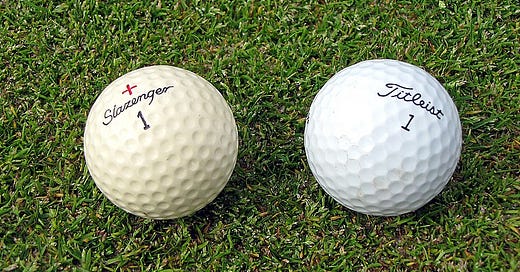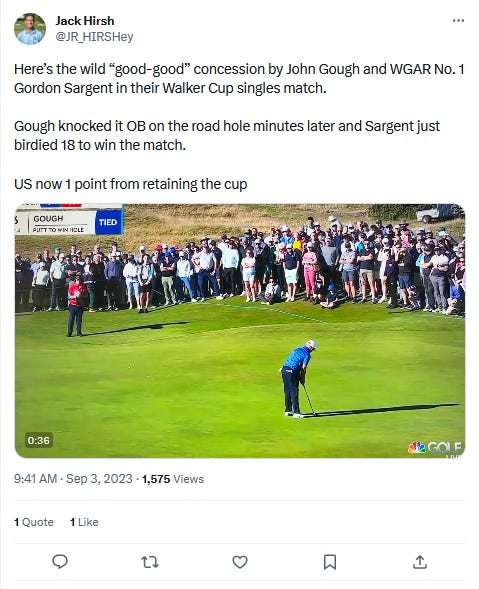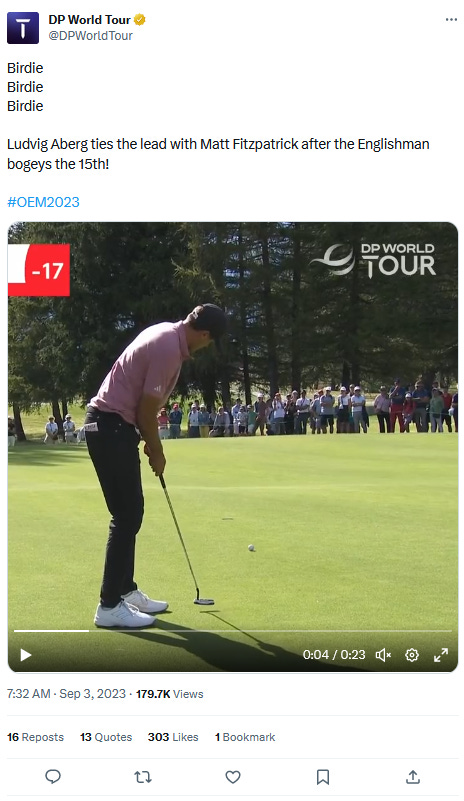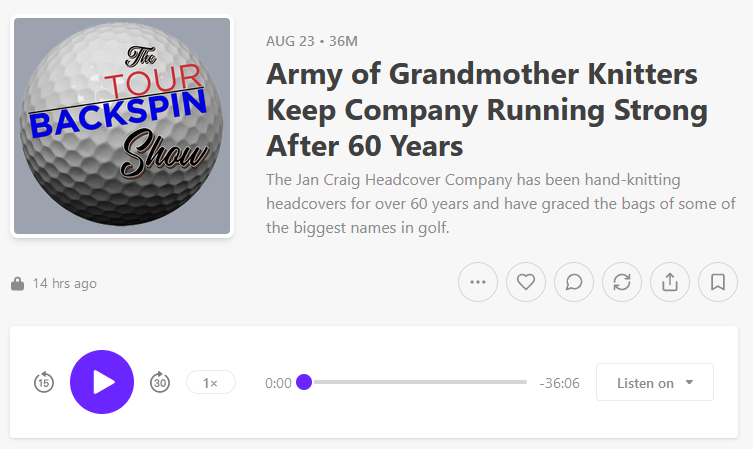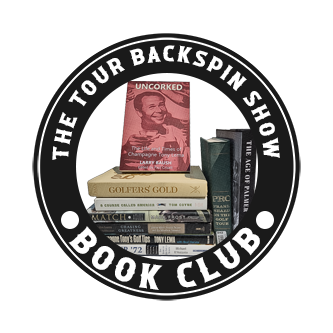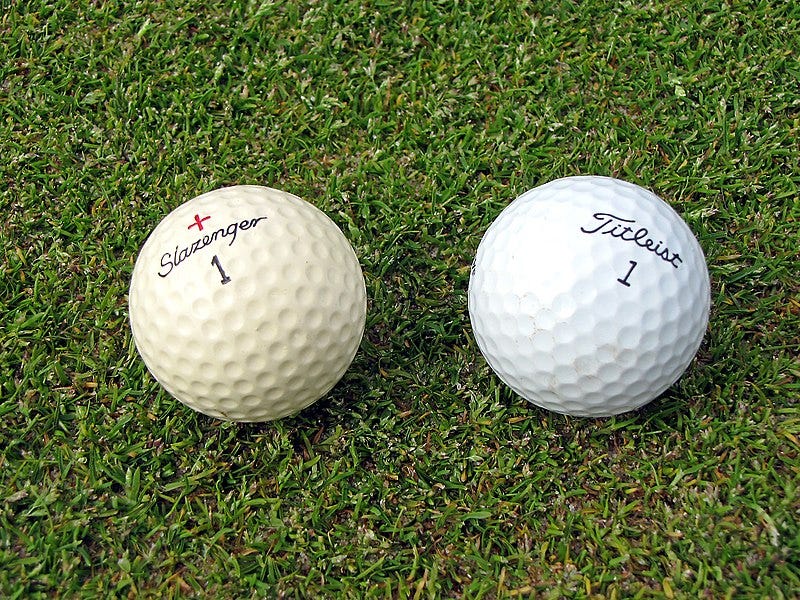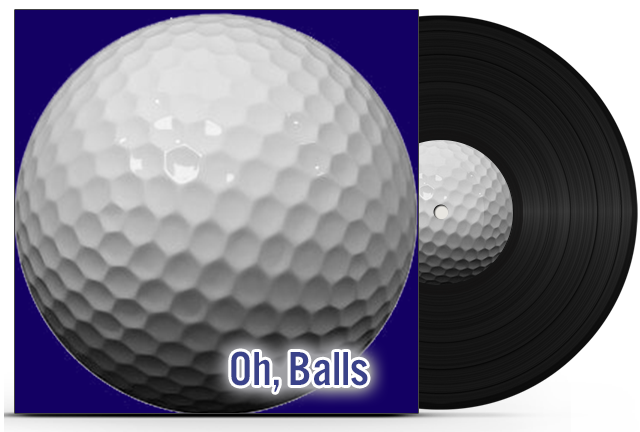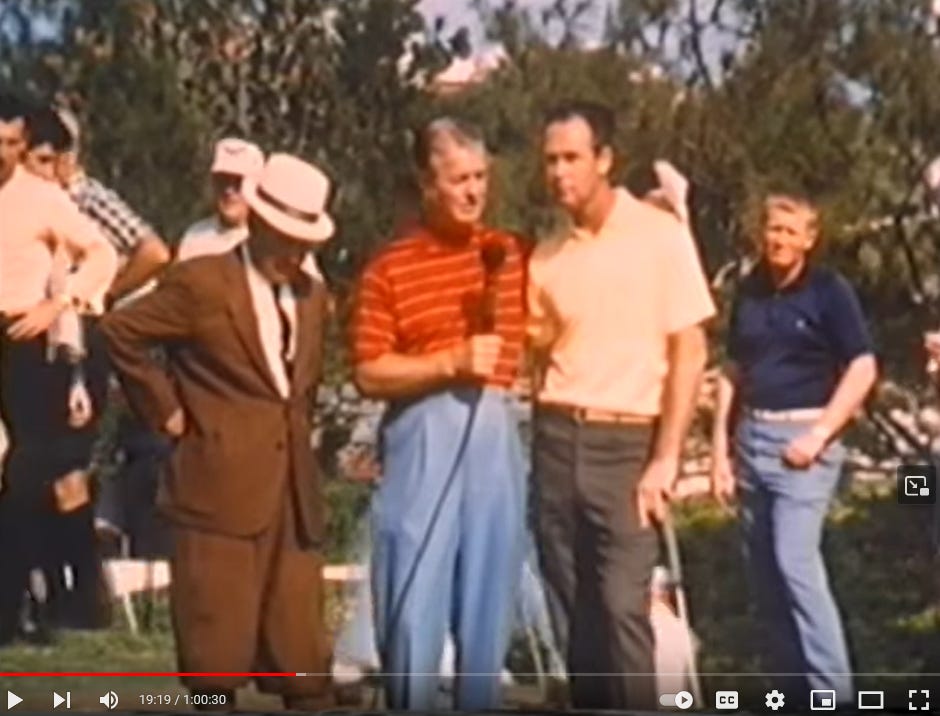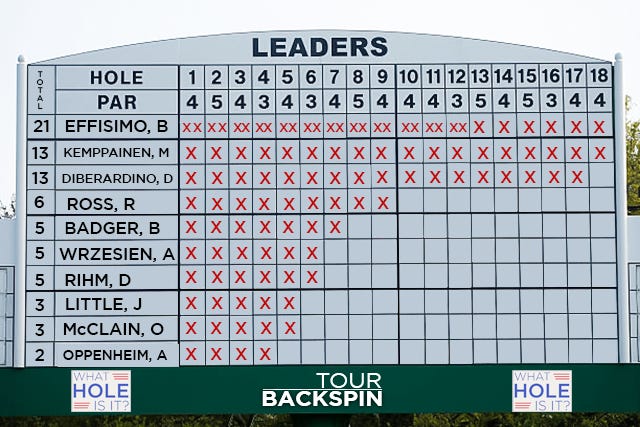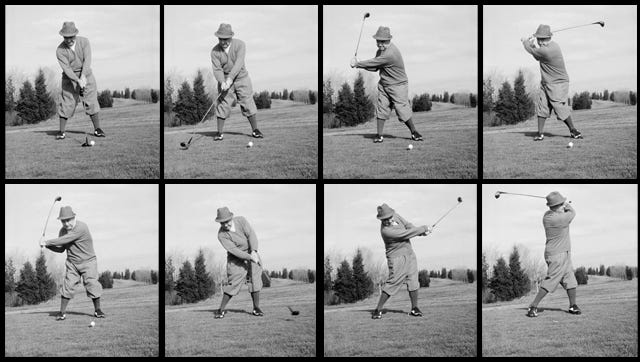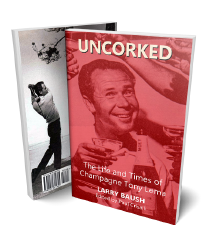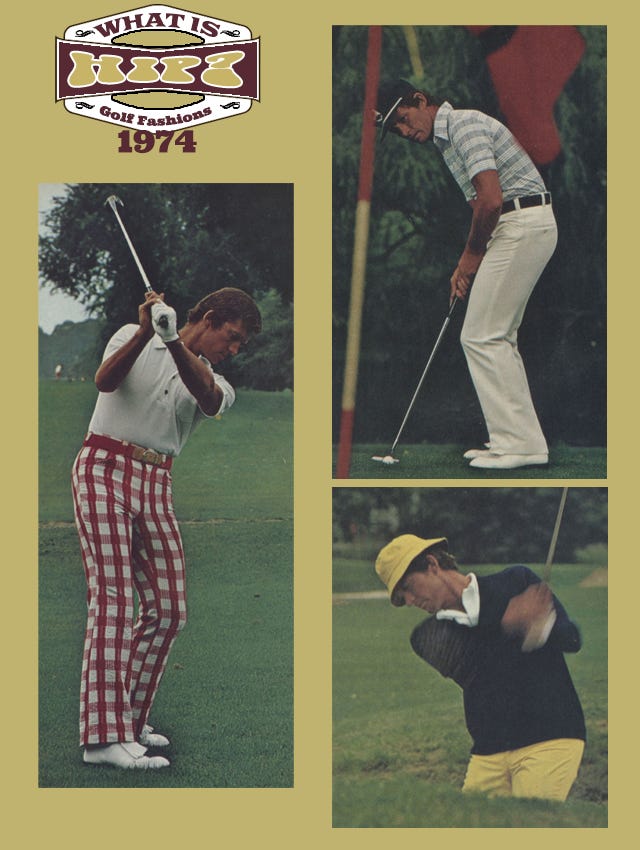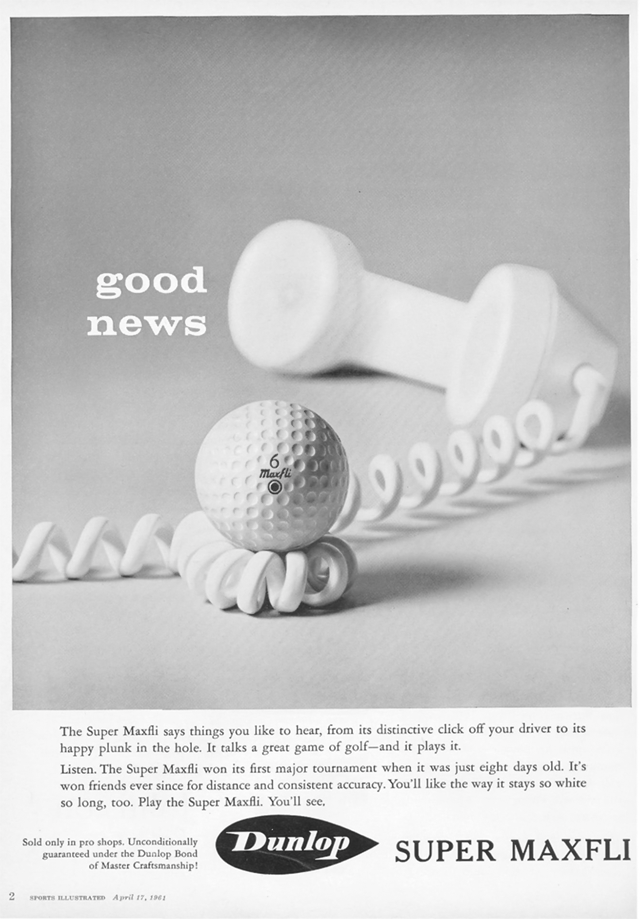Ball of Confusion, That's What The World is Today
A look back at when there was bifurcation of the golf ball in the world
With the PGA TOUR off for the week we’re looking into the golf ball this week. Specifically, the era of bifurcation when the USGA and the R&A had different specifications on the size of the ball. Scroll down to learn more.
In the absence of any action from the PGA TOUR it was left up to the DP World Tour to provide some excitement, and boy did they. Ludvig Aberg, a 23-year-old who turned pro in June after completing a stellar career at Texas Tech, birdied four of his final five holes to close with a 64 to win. He wrapped up a spot on the Euro Ryder Cup team with the win.
Here is the European Ryder Cup team announced on Monday.
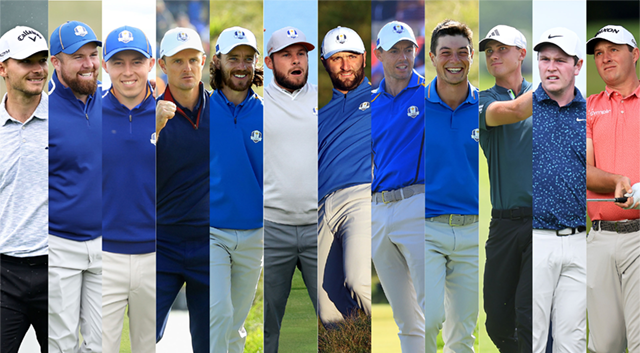
The Walker Cup also provided some golf viewing excitement as the team from the United States rallied on Sunday from a 7 ½ to 4 ½ deficit, the largest day one deficit that the U.S. team has faced in 34 years, to win the cup by a score of 14 ½ to 11 ½. The U.S. took three points in the morning on Sunday and then steamrolled the GB&I team in the singles matches Sunday afternoon. Hope the Ryder Cup can live up to this exciting match.
In last week’s Tour Backspin Poll, 56% of respondents thought that the handicapped start of the TOUR Championship made it a goofy net tournament while 44% of respondents thought the start rewarded good play throughout the year.
In this week’s Tour Backspin Poll, weigh in on this “good-good” concession at the Walker Cup.
Tour Backspin Poll
Clip You Might Have Missed
What a finish by Ludbig Aberg in the Omega European Masters.
This week, the PGA TOUR is again idle. The next scheduled event is the Fortinet Championship at Silverado in Napa, CA, starting September 14th. Then it is the Ryder Cup starting on September 21st! We’ll have some special content for the event.
I’m just hoping for a very competitive week with the outcome in doubt until the final matches on Sunday.
Hello, it’s long distance. Maxfli on the line. Check out what the 1961 Maxfli sounds like in this week’s Vintage Ad.
It’s all about balls in this week’s Tour Backspin Spotify playlist. Listen HERE.
Gene Sarazen and his plus fours timeless swing is featured in this week’s Swing Like a Pro. Scroll down to view.
Get the Tour Backspin Newsletter delivered to your email inbox for FREE.
We’ve got a great list of guests for the second season of The Tour Backspin Show. We have unlocked the kick-off to Season 2 with an episode on the Jan Craig Headcover Company. We have upcoming episodes featuring Al Geiberger taking us through his 59 at the 1979 Memphis Open, an interview with Lee Trevino, we check in with Frank Beard and Chuck Courtney. We’ll also be talking to legendary instructor Jim McLean and Skagit Golf and Country Club pro Craig Welty about Carl Welty. You don’t want to miss that one.
Listen to The Tour Backspin Show podcast on Substack with the above links, or on Spotify, Amazon Music, and Apple Podcast.
If you like golf history, check out the Your Golfer’s Almanac podcast. Host Michael Duranko celebrates birthdays, milestones, and other accomplishments that occurred on the day in golf history. Listen HERE.
Congratulations to Pepper Uno who correctly identified hole #16 at Rainier Golf and Country Club, in Seattle, WA, in last week’s WHAT HOLE IS IT? Pepper beat out three other correct answers in the random drawing and we have a signed copy of Uncorked, The Life and Times of Champagne Tony Lema in the mail to him. Check out the 2023 leader board and scroll down for your chance to win in this week’s WHAT HOLE IS IT? We’ve got some new prizes to hand out!
The Tour Backspin Show Book Club is brand-new and will give you an opportunity to discuss some of the best books about golf with some of the most talented writers in the genre. These virtual book club meetings will be conducted via Zoom and will allow you to join the discussion with the author about how they came to write their book and what challenges they faced during the process. These meetings are free, but you have to register for each meeting.
Save the Date! The first meeting of The Tour Backspin Show Book Club will meet on Thursday, Sept. 21st at 5 pm (PST) via Zoom. We’re going to start off with an easy one, as I will host the first meeting and we will discuss my book on Tony Lema, Uncorked, The Life and Times of Champagne Tony Lema. I will discuss what went into the writing of the book and I would love to hear your Tony Lema stories. Click on the “Register Now” and I look forward to seeing you on the 21st.
Register, for free, at tourbackspin.com through the below link.
We’re playing Three Balls and a Lie in this week’s Tour Backspin Quiz. Scroll down to play.
Did you miss a previous newsletter? You can view it HERE. Forward this email to a friend. Was this newsletter forwarded to you? You can sign up HERE.
Okay, we're on the tee, let's get going.
Enjoy!
Larry Baush
Big Ball or Small Ball? The Choice Was Up To You
It is early in the second week of July 1964 and the eight-man American contingent who had traveled to The Old Course in St. Andrews were preparing for The Open Championship. Jack Nicklaus, one of the American players who made the trip, discussed which ball he would play in the tournament, the smaller British ball, or the larger American ball.
Players could choose which ball to play, even switch back-and-forth during play, during this time of bifurcation between the rules of the R&A and the USGA, the two major governing bodies of the rules of golf. Because of this choice for players, it was always a matter of curiosity as to which ball would be played.
“Well, if the wind blows, good luck to him.”
Nicklaus informed the press that he would be playing the smaller British ball. The British ball was often called the small ball due to its maximum diameter of 1.62 inches compared to the maximum diameter of 1.68 for the American ball, often called the big ball. Because both balls weighed an identical 1.62 ounces, the British ball was denser and bore through the wind better than the big ball. Nicklaus calculated that he would get 25 more yards of distance with his drives using the small ball.
Reporters informed Nicklaus that Tony Lema intended to use the big ball during play that week and Nicklaus could only say, “Well, if the wind blows, good luck to him.”
With all the current talk of the proposed Model Local Rule (MLR) for elite players that would limit the distance of balls and would bring about a bifurcation of the rules, it’s interesting to go back to a time when two different balls were routinely used. Since the British ball was smaller than the minimum size under USGA rules, it was illegal for play in competitions conducted in areas governed by the USGA. The American ball was larger than the minimum size under the R&A rules which meant that it was legal in their jurisdictions, and players could even switch back-and-forth during a round of play, as long as the switch was made between holes and not during the play of a hole.
“Certain interested parties in the United States oppose the adoption of the 1.66 ball.”
In the early 1950s, the two governing bodies came together to standardize the rules of golf, but for some reason, they could not come to an agreement over the size of the ball. The bifurcation of the rules concerning balls lasted through the 1960s and into the 1970s.
In the early 1970s, the two governing bodies sought to establish a world-wide standard for the golf ball. They investigated the possibility of making that standard be a ball that measured 1.66 inch in diameter. But in 1973 the idea was abandoned. The reasons for that abandonment resonate with some of the reasons that have been given by the PGA TOUR, as well as today’s ball manufacturers, for opposing the proposed Model Local Rule.
“Certain interested parties in the United States oppose the adoption of the 1.66 ball,” a USGA announcement in 1973 read in part. No doubt those un-named parties included ball manufacturers, who were not inclined to re-tool plants to produce conforming balls.
The USGA did not put an end to the idea of ending the bifurcation of the ball.
The statement ended with, “The objective of achieving world-wide uniformity in all of the rules of the game continues to be a matter of vital concern to both the USGA and the R&A.”
That was the situation all the way up to 1990 when the rules on golf balls were finally standardized, at the 1.68-inch diameter ball.
World-wide uniformity in the ball was gaining steam since the British PGA tour (today’s DP World Tour) had made the big ball compulsory since 1969. The R&A put the final nail in the coffin for the small ball when, in 1974, they ruled that the big ball would be the only ball that could be used in The Open Championship being conducted at Royal Lytham and St. Annes.
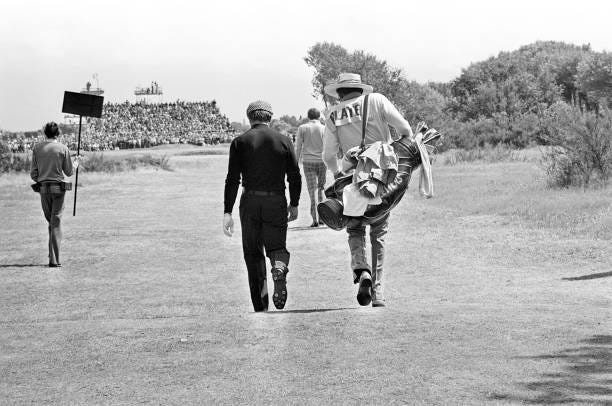
There was still a bifurcation concerning the rules for balls because players playing under the rules of the R&A could still choose which ball to use, except when playing in The Open Championship. That was the situation all the way up to 1990 when the rules on golf balls were finally standardized, at the 1.68-inch diameter ball. Ever since, we’ve had one size of golf ball—until the Model Local Rule was announced by the USGA this year.
While players will not have a choice, as Jack Nicklaus and Tony Lema did in 1964 at The Open Championship, we’re back to having a bifurcation of the rules when it comes to the golf ball. In that 1964 Open Championship, Lema abandoned his plans to use the big ball and used the small ball on his way to winning the Claret Jug, his first and only major championship, while Jack Nicklaus finished second, one of his 19 runner-up finishes in his career.
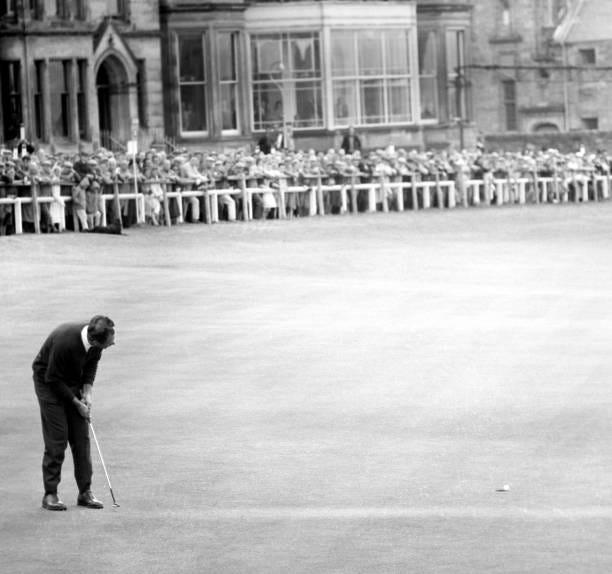
Follow us on Facebook, Instagram, Twitter, YouTube and Threads
Tour Backspin Playlist
Thanks for reading! Please let your family, friends and colleagues know they
can sign up for email delivery of this free newsletter through this link.
Bonus Story
In late April of 1966, Tony Lema met Peter Alliss in a match for Shell’s Wonderful World of Golf, played at the Mid-Ocean Golf Club in St. George’s, Bermuda. Being in Bermuda, the course fell under the realm of the R&A rules which meant that players could choose between the smaller British ball, or the larger American ball. They could even switch between the two (between holes, not during play of a hole), depending on wind conditions.
Lema did switch from one ball to the other, and after holing out on the second green, he joined the hosts of the show, Gene Sarazen and Jimmy Demaret, at the edge of the green for a short Q&A. They asked him about his strategy for choosing which ball he would use. Lema explained that he would use the smaller ball on holes into the wind, or when he needed some extra distance off the tee.
Demaret then asked Sarazen if he ever employed this type of strategy when choosing which ball to play. Sarazen appeared to begin to answer in the negative when Lema hijacked the microphone.
“He only had big balls in his day,” Lema joked. The three men broke up laughing and the comment somehow made it past the usually stringent censors at Shell.
WHAT HOLE IS IT?
Are you on the leader board?
Tour Backspin Quiz | Three Balls and a Lie
Three of these ball brands are, or were, real, while one is fake. Can you tell which one?
1.) Hi-Matic
2.) First-Flight Steel Power Center
3.) Red Dart
4.) Ram Lightning 500
Scroll down to for answer
Swing Like a Pro
The timeless beauty of Gene Sarazen’s swing (Photo: Leonard Kamsler | Getty Images)
Blind Shot
Click for something fun. 👀
Shooting 60 during a casual round is no problem for Jon Rahm. But, when the drinks began to flow? Read it HERE from Golf Digest.
Uncorked, The Life and Times of Champagne Tony Lema tells the story of one of the tour’s biggest stars in the mid-1960s. A fascinating glimpse into the traveling caravan that was the PGA TOUR during an era where the fields were full of “Mad Men” era personalities. From a hardscrabble youth spent on the “wrong side of the tracks” in the Oakland suburb of San Leandro, to the temptations of Elko, Nevada, to the bright lights of the PGA TOUR, Uncorked tells a story of determination, redemption and, above all else, a love story that documents how Betty, Tony’s new wife, provided the direction and motivation for him to become a top star. Order on Amazon.
What is Hip?
1974 fashions from Jockey (photo: Golf Digest)
Tour Backspin Quiz Answer:
We made up the Red Dart (#3).
If you’re enjoying the free version of Tour Backspin, I hope you would consider upgrading to a paid subscription ($5 per month, or $36 per year). Your support helps us with the research, writing, travel, and the other work required to make this newsletter sustainable. I understand that not everyone can or wants to buy a paid subscription. I’m happy to have you here either way. I’m glad you feel that the stories of these players from one of golf’s “Golden Ages” are important to document before it is too late. Thanks for reading.
Vintage Ad
Final Thoughts
How fun was it to watch match play on The Old Course at St. Andrews? More, please.
How cool was Gene Sarazen?
I remember playing the small ball. It was fun.


